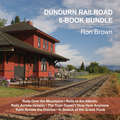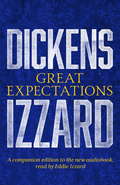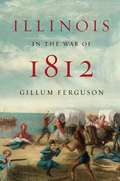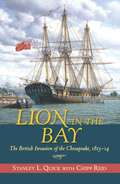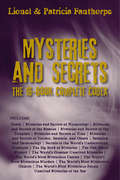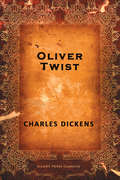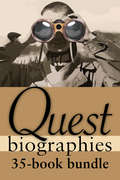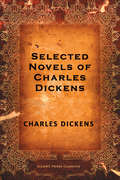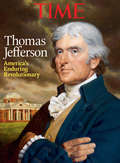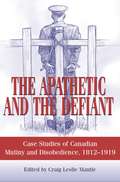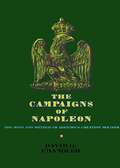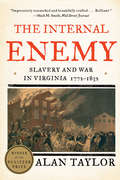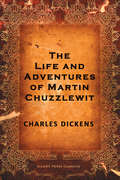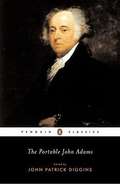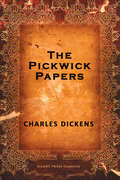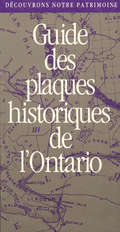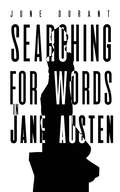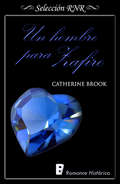- Table View
- List View
Dundurn National Historic Site: Inside Hamilton's Museums
by John GoddardInside Hamilton’s Museums helps to satisfy a growing curiosity about Canada’s steel capital as it evolves into a post-industrial city and cultural destination. In this special excerpt we visit Dundurn Castle, which once stood as the biggest house in British North America and reflected the outsized personality of its builder, Sir Allan Napier MacNab. Of Hamilton's museums, Dundurn Castle ranks as the biggest and most famous. The grounds host the Hamilton Military Museum, which specializes in the War of 1812. John Goddard takes us on a detailed tour of the historic home, providing fascinating historical background and insight.
Dundurn Railroad 6-Book Bundle: Rails Over the Mountains / Rails to the Atlantic / Rails Across Ontario / and 3 more
by Ron BrownA must for any Canadian railroad aficionado, this special bundle gathers six books in one for a can’t-miss retrospective of the nation’s railway history. Rails Over the Mountains Explore western Canada’s rich railway history, travelling from the grand railway hotels and rustic stations to relive a time when trains used to rumble in the West. Rails to the Atlantic Explore eastern Canada’s railway heritage, including stations from the late 1850s, grand hotels, bridges, and roundhouses. The Train Doesn't Stop Here Anymore Once the lifeblood of Canada, railways and heritage stations are a fading part of the patrimony of communities across the nation. Rails Across Ontario Train buffs and history lovers now have a book that explores the heritage of Ontario’s railways, from its oldest stations to its highest bridges, most glamorous hotels and historic train rides. Rails Across the Prairies Canada’s rail lines were pivotal in establishing the icons that mark today’s landscape: massive bridges, sentinel-like grain elevators, pattern-book wayside stations. In Search of the Grand Trunk Discover the legacy and lore of Ontario’s railway era by exploring the lost and abandoned rail lines that once were essential to the province’s well-being.
Frankenstein: The 200th Anniversary Edition (Enriched Classics)
by Mary ShelleyENDURING LITERATURE ILLUMINATED BY PRACTICAL SCHOLARSHIP A timeless, terrifying tale of one man's obsession to create life -- and the monster that became his legacy. EACH ENRICHED CLASSIC EDITION INCLUDES: A concise introduction that gives readers important background information A chronology of the author's life and work A timeline of significant events that provides the book's historical context An outline of key themes and plot points to help readers form their own interpretations Detailed explanatory notes Critical analysis, including contemporary and modern perspectives on the work Discussion questions to promote lively classroom and book group interaction A list of recommended related books and films to broaden the reader's experience Enriched Classics offer readers affordable editions of great works of literature enhanced by helpful notes and insightful commentary. The scholarship provided in Enriched Classics enables readers to appreciate, understand, and enjoy the world's finest books to their full potential. SERIES EDITED BY CYNTHIA BRANTLEY JOHNSON
Great Expectations: Narrated by Eddie Izzard
by Charles DickensThe classic Charles Dickens novel - now also available as an audiobook narrated by Eddie Izzard, one of Britain's greatest comediansWidely considered to be Charles Dickens' greatest and best-loved work, Great Expectations was first published as a serial between December 1860 - August 1861 and has been in print ever since. The story of a young boy from humble origins who dares to dream of becoming a gentleman, it is one of Dickens' most enduring and widely adapted novels.
Illinois in the War of 1812
by Gillum FergusonRussell P. Strange "Book of the Year" Award from the Illinois State Historical Society, 2012. On the eve of the War of 1812, the Illinois Territory was a new land of bright promise. Split off from Indiana Territory in 1809, the new territory ran from the junction of the Ohio and Mississippi rivers north to the U.S. border with Canada, embracing the current states of Illinois, Wisconsin, and a part of Michigan. The extreme southern part of the region was rich in timber, but the dominant feature of the landscape was the vast tall grass prairie that stretched without major interruption from Lake Michigan for more than three hundred miles to the south. The territory was largely inhabited by Indians: Sauk, Potawatomi, Kickapoo, and others. By 1812, however, pioneer farmers had gathered in the wooded fringes around prime agricultural land, looking out over the prairies with longing and trepidation. Six years later, a populous Illinois was confident enough to seek and receive admission as a state in the Union. What had intervened was the War of 1812, in which white settlers faced both Indians resistant to their encroachments and British forces poised to seize control of the upper Mississippi and Great Lakes. The war ultimately broke the power and morale of the Indian tribes and deprived them of the support of their ally, Great Britain. Sometimes led by skillful tacticians, at other times by blundering looters who got lost in the tall grass, the combatants showed each other little mercy. Until and even after the war was concluded by the Treaty of Ghent in 1814, there were massacres by both sides, laying the groundwork for later betrayal of friendly and hostile tribes alike and for ultimate expulsion of the Indians from the new state of Illinois. In this engrossing new history, published upon the war's bicentennial, Gillum Ferguson underlines the crucial importance of the War of 1812 in the development of Illinois as a state. The history of Illinois in the War of 1812 has never before been told with so much attention to the personalities who fought it, the events that defined it, and its lasting consequences. Endorsed by the Illinois Society of the War of 1812 and the Illinois War of 1812 Bicentennial Commission.
Lion In The Bay: The British Invasion Of The Chesapeake, 1813-14
by Chipp Reid Stanley L. QuickThis is the story of the War of 1812 like no other, brought to life in narrative form with pinpoint historical details. As the War of 1812 raged on the high seas and along the Canadian border, the British decided to strike at the heart of the United States, the relatively undefended area of the Chesapeake Bay. The Chesapeake was a fertile farm region, a renowned place of shipbuilding and an area divided along political lines over the war. Admiral George Cockburn led the British into the bay in March 1813. After a failed attempt to take Norfolk, Cockburn led the British up and down the Chesapeake. Originally a campaign to relieve pressure from other fronts, the Chesapeake theater soon became a campaign of retribution for the British, turning what had been an economic engine for America into a region of terrorized citizens, destroyed farms and fears of slave insurrection. The blockade choked American commerce and prevented privateers from taking the war to the English. Cockburn returned in 1814 and once more terrorized the residents on both shores of the Chesapeake while stoking the political divisions that also rent the country. In August, 1814, the British capitalized on the refusal of President James Madison to bolster the defenses of the waterway that led to the nation’s capital. Cockburn again led a naval force into the bay, but this time he ran into opposition from Commodore Joshua Barney and his polyglot flotilla of warships. Barney put up an heroic though doomed fight before the British landed at Benedict, Md. , in August, 1814 and marched on Washington, D. C. After defeating the Americans at Bladensburg, the British burned Washington before returning to their boats and setting out for Baltimore. There, the British armada ran into Fort McHenry and a stalwart group of defenders. Despite a massive bombardment, the British could not silence the fort or the city’s other defenses, forcing them to retreat and give up their campaign to completely shut the Chesapeake. The victory at Baltimore, coupled with victories on the Great Lakes, helped turn the war in America’s favor.
Little Dorrit: Parts One And Two
by Charles DickensA satirical critique of British bureaucracy and the impossibility of social mobility, Little Dorrit tells the story of kind-hearted Amy Dorrit and Arthur Clennam, both of whom are unaware that their family histories have been fabricated to cover a complex web of secrets and lies. After living with his father in China for twenty years, Arthur returns home to London to inform his mother of his father's death. Before he died, however, his father gave him a mysterious watch. This gift sets in motion revelations and confessions that change both Arthur and Amy's fortunes.
Mysteries and Secrets: Mysteries and Secrets of Numerology / Mysteries and Secrets of the Masons / and 14 more
by Lionel And FanthorpeThis special 16-book bundle collects fearless investigations into the paranormal from the pens of Lionel and Patricia Fanthorpe, who for several decades been researching and writing about ancient and eternal mysteries. Their entertaining and thought-provoking works span numerous topics, from numerology, freemasonry, voodoo, satanism and witchcraft to the very nature of death and time. Additionally, they have produced numerous volumes examining the great unexplained mysteries and places of history, including The Bible, European castles, strange murders, arcane objects of power, the mysterious depths of the sea and remarkable people. Take a strange and beautiful trip to the mystical side of life in this special set! Includes Death Mysteries and Secrets of Numerology Mysteries and Secrets of the Masons Mysteries and Secrets of the Templars Mysteries and Secrets of Time Mysteries and Secrets of Voodoo, Santeria, and Obeah Satanism and Demonology Secrets of the World’s Undiscovered Treasures The Big Book of Mysteries The Oak Island Mystery The World’s Greatest Unsolved Mysteries The World’s Most Mysterious Castles The World’s Most Mysterious Murders The World’s Most Mysterious Objects The World’s Most Mysterious People Unsolved Mysteries of the Sea
Nicholas Nickleby: Classics Illustrated
by Charles DickensNicholas Nickleby, the title hero of Charles Dickens' third novel, finds himself responsible for supporting his mother and sister after his father's death. His Uncle Ralph, a cruel and selfish businessman, provides Nicholas with a low-paying job working for the wicked Squeers, a man who, with his wife, runs a brutal boarding school for unwanted children. The Squeers treat the children terribly, and eventually Nicholas is pushed beyond his breaking point. He stands up to Squeers and escapes with one of the children. Their adventures and quest to provide for Nicholas' family pit them against the evil Uncle Ralph and the powers of injustice.
Oliver Twist: Or The Parish Boy's Progress...
by Charles DickensOne of Charles Dickens' most iconic tales, Oliver Twist follows the life of an orphan boy in London struggling to survive amidst brutal conditions. After escaping a deadend life in a workhouse, Oliver falls in with a group of young pickpockets, headed by the corrupt and exploitative Fagin. An enduring social commentary with elements of satire and dark humour, Dickens' second novel is one of the most popular ever published, having been adapted numerous times in film, theatre, television and more. It is also a compelling critique of social and economic conditions in Victorian England.
Quest Biographies Bundle — Books 31–35: Harriet Tubman / Laura Secord / Joey Smallwood / Prince Edward, Duke of Kent / John A. Macdonald
by Ged Martin Peggy Dymond Leavey Nathan Tidridge Rosemary Sadlier Ray Argyle Brigadier-General, The Hon. J.J. GrantPresenting five titles in the Quest Biography series that profiles prominent figures in Canada’s history. The important Canadian lives detailed here are: legendary Underground Railroad leader Harriet Tubman; Laura Secord, heroine of the War of 1812; Newfoundland politician Joey Smallwood, the final Father of Confederation; Prime Minister John A. Macdonald, the primary founder of Canada; and onetime governor general Prince Edward, the Duke of Kent, an important figure in Canada’s early development. Includes Harriet Tubman Laura Secord Joey Smallwood Prince Edward, Duke of Kent John A. Macdonald
Quest Biography 35-Book Bundle: Marshall McLuhan, Nellie McClung, René Lévesque and many more
by Edward Butts John Wilson Arthur Slade Kathryn Bridge Sharon Stewart Roderick Stewart Heather Kirk Ged Martin T. F. Rigelhof Tom Henighan Peggy Dymond Leavey Nathan Tidridge Rosemary Sadlier Nicholas Maes Ray Argyle Julie H. Ferguson Valerie Knowles Deborah Cowley Wayne Larsen Michelle Labrèche-Larouche Raymond Plante Kate Braid Judith Fitzgerald Margaret Macpherson Lian Goodall Marguerite Paulin Francine Legaré Gary Evans Tom Shardlow Anne Cimon André Vanasse D. T. LaheyThis special bundle contains the first thirty-five books in the Quest Biography series, which profiles the lives of Canadians who have had a profound effect on their country and the world. Some of these figures are truly famous, while others were quietly influential. Among the wide variety of people we meet are: prime ministers (Mackenzie King, Macdonald, Laurier, and more); artists (Emily Carr, Tom Thomson); explorers (David Thompson, Samuel de Champlain), politicians (René Lévesque, Joey Smallwood), writers (Robertson Davies, Gabrielle Roy), entertainers (Emma Albani, Mary Pickford), activists (Nellie McClung, Louis Riel, Harriet Tubman), and many, many more. Let this series be your primer on the greatest figures in Canadian history. Includes Emma Albani Emily Carr George Grant Jacques Plante John Diefenbaker John Franklin Phyllis Munday Wilfrid Laurier William Lyon Mackenzie King René Lévesque Samuel de Champlain John Grierson Lucille Teasdale Maurice Duplessis David Thompson Mazo de la Roche Susanna Moodie Gabrielle Roy Louis Riel James Wilson Morrice Vilhjalmur Stefansson Robertson Davies James Douglas William C. Van Horne George Simpson Tom Thomson Simon Girty Mary Pickford Harriet Tubman Laura Secord Joey Smallwood Prince Edward, Duke of Kent John A. Macdonald Marshall McLuhan
Selected Novels of Charles Dickens
by Charles DickensThis special ebook edition includes some of the most popular novels written by Charles Dickens: The Posthumous Papers of the Pickwick Club, Oliver Twist, Nicholas Nickleby, The Old Curiosity Shop, A Christmas Carol, The Life and Adventures of Martin Chuzzlewit, David Copperfield, Bleak House, Hard Times, Little Dorrit, A Tale of Two Cities, and Great Expectations.
TIME Thomas Jefferson: America's Enduring Revolutionary
by The Editors of TIMEThomas Jefferson remains a potent influence in America more than 200 years after his birth. TIME examines his lasting and sometimes controversial legacy as revolutionary, president and diplomat through his political beliefs and battles, his extraordinary achievements, including the westward expansion of the young United States; as well as his letters and writings, from the Declaration of Independence to his own, personally edited version of the New Testament. TIME also explores Jefferson's enduring influence on our culture, as the founding father of American architecture, our higher education system and the slow food movement--and even planting the seeds for America's modern, flourishing wine industry.
The Apathetic and the Defiant: Case Studies of Canadian Mutiny and Disobedience, 1812-1919
by Craig L. MantleCanadian soldiers have served their country for centuries, and for the most part they have done so honourably and loyally. Yet, on certain occasions, their conduct has been anything but honourable. Whether by disobeying their legal orders, terrorizing the local population, or committing crimes in general, some soldiers have embodied the very antithesis of appropriate military conduct. Covering examples of unsavoury behaviour in the representatives of our military forces from the War of 1812 to the immediate aftermath of the First World War, The Apathetic and the Defiant reveals that disobedience and mutiny have marked all of the major conflicts in which Canada has participated. Canadian military indiscipline has long been overshadowed by the nation’s victories and triumphs … until now.
The Campaigns of Napoleon: The Mind And Method Of History's Greatest Soldier
by David G. ChandlerNapoleonic war was nothing if not complex -- an ever-shifting kaleidoscope of moves and intentions, which by themselves went a long way towards baffling and dazing his conventionally-minded opponents into that state of disconcerting moral disequilibrium which so often resulted in their catastrophic defeat." The Campaigns of Napoleon is an exhaustive analysis and critique of Napoleon's art of war as he himself developed and perfected it in the major military campaigns of his career. Napoleon disavowed any suggestion that he worked from formula ("Je n'ai jamais eu un plan d'opérations"), but military historian David Chandler demonstrates this was at best only a half-truth. To be sure, every operation Napoleon conducted contained unique improvisatory features. But there were from the first to the last certain basic principles of strategic maneuver and battlefield planning that he almost invariably put into practice. To clarify these underlying methods, as well as the style of Napoleon's fabulous intellect, Mr. Chandler examines in detail each campaign mounted and personally conducted by Napoleon, analyzing the strategies employed, revealing wherever possible the probable sources of his subject's military ideas. The book opens with a brief account of Bonaparte's early years, his military education and formative experiences, and his meteoric rise to the rank of general in the army of the Directory. Introducing the elements of Napoleonic "grand tactics" as they developed in his Italian, Egyptian, and Syrian campaigns, Mr. Chandler shows how these principles were clearly conceived as early as the Battle of Castiglione, when Napoleon was only twenty -six. Several campaigns later, he was Emperor of France, busily constructing the Grande Armée. This great war machine is described in considerable detail: the composition of the armies and the élite Guard; the staff system and the methods of command; the kind of artillery and firearms used; and the daily life of the Grande Armée and the all-seeing and all-commanding virtuoso who presided over every aspect of its operation in the field. As the great machine sweeps into action in the campaigns along the Rhine and the Danube, in East Prussia and Poland, and in Portugal and Spain, David Chandler follows closely every move that vindicates -- or challenges -- the legend of Napoleon's military genius. As the major battles take their gory courses -- Austerlitz, Jena, Fried-land -- we see Napoleon's star reaching its zenith. Then, in the Wagram Campaign of 1809 against the Austrians -- his last real success -- the great man commits more errors of judgment than in all his previous wars and battles put together. As the campaigns rage on, his declining powers seem to justify his own statement: "One has but a short time for war." Then the horrors of the Russian campaign forever shatter the image of Napoleonic invincibility. It is thereafter a short, though heroic and sanguinary, road to Waterloo and St. Helena. Napoleon appears most strikingly in these pages as the brilliant applier of the ideas of others rather than as an original military thinker, his genius proving itself more practical than theoretical. Paradoxically, this was both his chief strength and his main weakness as a general. After bringing the French army a decade of victory, his methods became increasingly stereotyped and, even worse, were widely copied by his foes, who operated against him with increasing effectiveness toward the end of his career. Yet even though his enemies attempted to imitate his techniques, as have others in the last century and a half, no one ever equaled his success. As these meticulous campaign analyses testify, his multifaceted genius was unique. Even as the end approached, as David Chandler points out, his eclipse was "the failure of a giant surrounded by pygmies." "The flight of the eagle was over; the 'ogre' was safely caged at last, and an exhausted Europe settled down once more to attempt a return to former ways of life and government. But the shade of Napoleon lingered on irresistibly for m...
The Internal Enemy: Slavery and War in Virginia, 1772-1832
by Alan TaylorThis searing story of slavery and freedom in the Chesapeake by a Pulitzer Prize-winning historian reveals the pivot in the nation's path between the founding and civil war.<P><P> Frederick Douglass recalled that slaves living along Chesapeake Bay longingly viewed sailing ships as "freedom's swift-winged angels." In 1813 those angels appeared in the bay as British warships coming to punish the Americans for declaring war on the empire. Over many nights, hundreds of slaves paddled out to the warships seeking protection for their families from the ravages of slavery. The runaways pressured the British admirals into becoming liberators. As guides, pilots, sailors, and marines, the former slaves used their intimate knowledge of the countryside to transform the war. They enabled the British to escalate their onshore attacks and to capture and burn Washington, D.C. Tidewater masters had long dreaded their slaves as "an internal enemy." By mobilizing that enemy, the war ignited the deepest fears of Chesapeake slaveholders. It also alienated Virginians from a national government that had neglected their defense. Instead they turned south, their interests aligning more and more with their section. In 1820 Thomas Jefferson observed of sectionalism: "Like a firebell in the night [it] awakened and filled me with terror. I considered it at once the knell of the union." The notes of alarm in Jefferson's comment speak of the fear aroused by the recent crisis over slavery in his home state. His vision of a cataclysm to come proved prescient. Jefferson's startling observation registered a turn in the nation's course, a pivot from the national purpose of the founding toward the threat of disunion. Drawn from new sources, Alan Taylor's riveting narrative re-creates the events that inspired black Virginians, haunted slaveholders, and set the nation on a new and dangerous course.<P> Winner of the 2014 Pulitzer Prize for History<P>
The Life and Adventures of Martin Chuzzlewit
by Charles DickensMartin Chuzzlewit is raised by his wealthy grandfather and namesake, and together the two live with Mary, a young woman the senior Martin hired to take care of him. When a rift concerning Mary tears the two Chuzzlewit men apart, the younger Martin leaves and several selfish and nefarious relatives arrive, hoping to inherit the old man's wealth. After a series of adventures through which he learns what is most important to him, Martin Junior returns to defend his grandfather. Dickens thought The Life and Adventures of Martin Chuzzlewit to be amongst his best work, but it was one of his least popular books during his life. It has endured, however, as a moving tale of family loyalty, peppered with Dickens' signature satirical wit.
The Portable John Adams
by John Adams Jack DigginsIn addition to being an uncompromising defender of liberty, esteemed diplomat, and successor to George Washington, John Adams was a passionate and prolific writer. Adams biographer John Patrick Diggins gathers an impressive variety of his works in this compact, original volume, including parts of his diary and autobiography, and selections from his rich correspondence with this wife, Abigail, Thomas Jefferson, and others. The Portable John Adams also features his most important political works: "A Dissertation on Canon and Feudal Law," "Thoughts on Government," "A Defense of Constitutions," "Novanglus," and "Discources in Davila." There is no finer introduction to the protean genius of this seminal American philosopher. First time in Penguin Classics
The Posthumous Papers of the Pickwick Club: The Pickwick Papers
by Charles DickensCharles Dickens' first novel, The Pickwick Papers, was a phenomenal success upon its release. Like most of Dickens' work, it was first published in serial form, where it became the most popular reading of the day. The Pickwick Papers tells the story of Samuel Pickwick, a good-hearted old gentleman and president of the Pickwick Club. With three other members of the club, Pickwick travels around the English countryside, where he becomes caught up in a serious of comic adventures, from romantic and legal misunderstandings. Though light in tone, the novel foreshadows the social concerns that would emerge in Dickens' later work.
Union 1812
by A. J. LangguthBy the author of the acclaimed Patriots: The Men Who Started the American Revolution, a gripping narrative that tells the story of the second and final war of independence that secured the nation's independence from Europe and established its claim to the entire continent. The War of 1812 has been ignored or misunderstood. Union 1812 thrillingly illustrates why it must take its place as one of the defining moments in American history.
Découvrons Notre Patrimoine: Guide des plaques historiques de l'Ontario
by Mary Ellen Perkins Nicole AndreDepuis que le programme de commémoration historique a été inauguré par le gouvernement de l’Ontario en 1956, plus de 1 000 plaques ont été érigées d’un bout à l’autre de la province. La variété des sujets commémorés est étonnante, qu’il s’agisse de ruées vers les mines du nord de l’Ontario ou de l’invention de la vis à tête creuse … de Harold Innis ou de Stephen Leacock … de l’épidemie de typhus de 1847 ou de la découverte de l’insuline. La culture populaire est également bien représentée: "Beautiful Joe" commémore un roman célêbre dans le monde entier racontant l’histoire d’un chien ; "When You and I Were Young, Maggie" chante une ballade romantique très en vogue ; "Jumbo" marque l’emplacement où est mort un éléphant de cirque très aimé. L’histoire de l’Ontario, tout comme sa géographie et ses habitants, est vaste et variée. Ce guide peut donc être utile, que l’on circule sur l’autoroute, se promène a la campagne ou flâne dans son propre quartier. Il reste encore tant à découvrir.
Infiernos de pasión (Los Kinsberly #Volumen 3)
by Evelin MordánUna historia donde el perdón no existe, pero el amor sí. Ella# Byron Kinsberly se lo arrebató todo, y estaba dispuesta a vengarse. Pero cuando entre ellos surge un amor inesperado e inoportuno, Sofía olvida su lucha contra él para luchar contra un enemigo que amenaza con dañar a lo que más le importa. Él# Sofía Jackson le devolvió las ganas de vivir. Y cuando más vivo se sentía, descubre un destructor secreto que lo sumirá en la más profunda oscuridad. Para salir, sin embargo, solo puede sacarlo la mujer que ama, a quien ha jurado crucificar en el infierno.
Searching for Words in Jane Austen
by June DurantThere are crosswords, codewords, wordsearch and even letter Sudoku, but here is something different with a Jane Austen theme: hidden words to be found in appropriate sentences. Subjects range from her life and her writing to her Georgian and Regency world. Those in the know will enjoy allusions and may even learn something new. The information is light reading designed to appeal to newcomers.
Un hombre para Zafiro (Joyas de la nobleza #Volumen 3)
by Catherine BrookUn amor profundo que surgió de la desesperación. Zafiro Loughy siempre se ha considerado una mujer juiciosa, incapaz de cometer un acto que pudiera significar un escándalo. Sin embargo, una insensatez llevó a otra y una situación desesperada la hizo tomar una decisión precipitada: perdirle al hombre que la secuestró por error que se casara con ella. Julian, conde de Granard, estaba consternado, su padre le había dejado muchas deudas en herencia y estaba a punto de ahogarse en ellas. Cuando sus imprudentes hermanos decidieron secuestrar a una condesa para obligar a esta a devolver unas joyas que les robó, no pudo ser mayor la sorpresa al darse cuenta de que a quien habían secuestrado no era la condesa, sino una joven soltera, que, aunque la sociedad dijera lo contrario, debía estar loca, pues le pidió matrimonio. Su orgullo se negó a ese absurdo, pero la mujer consiguió convencerlo para fugarse a Gretna a Green, dando comienzo a lo que ninguno de los dos esperaba que fuera una hermosa historia de amor.

